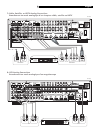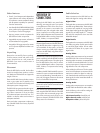
17
English
Other features
• Zone 2, 3, and 4 outputs with independent
input selection and volume adjustments
for multi-zone custom installations along
with IR-repeater capability for operation
from the remote zone.
• User friendly ON-SCREEN DISPLAY (OSD)
menu system with programmable labels
for all inputs. Choice of languages.
• Learning remote control to operate the
RSP-1069 and other components.
• Upgradable microprocessor software to
accommodate future upgrades.
• Assignable 12V trigger outputs for remote
turn-on of power amplifiers and other com
-
ponents.
Unpacking
Remove the unit carefully from its packing.
Find the remote control and other acces
-
sories. Save the box as it will protect the
RSP-1069 if you move or need to return it
for maintenance.
Placement
Place the RSP-1069 on a solid, level surface
away from sunlight, heat, moisture, or vibra
-
tion. Make sure that the shelf can support the
weight of the unit.
Place the RSP-1069 close to the other compo
-
nents in your system and, if possible, on its
own shelf. This will make initial hookup, and
subsequent system changes easier.
The RSP-1069 can generate heat during nor
-
mal operation. Do not block ventilation open
-
ings. Allow a minimum of 10 cm (4 inches)
of unobstructed space around the unit. If in-
stalled in a cabinet, make sure that there is
adequate ventilation.
Don’t stack other components or objects on
top of the RSP-1069. Don’t let any liquid fall
into the unit.
OVERVIEW OF
CONNECTIONS
Although the RSP-1069’s rear panel looks
daunting, connecting the unit to your system
is straightforward. Each of the source com-
ponents in the system is connected to the
RSP-1069 inputs with a digital audio cable
(coax or optical) or an analog audio cable
(RCA). Video components are connected with
a digital HDMI cable or analog Component
Video, S-Video, or composite cables.
NOTE: Surround formats like Dolby Digital and
DTS are digital formats and the RSP-1069 can
only decode them when a digital input sig-
nal is available. For this reason, you should
always connect your DVD player’s digital
outputs to the RSP-1069, using either the op
-
tical or coax inputs.
The RSP-1069’s audio output signals are sent to
power amplifier(s) with standard RCA cables
from preamp audio outputs. The video signal
from the RSP-1069 is sent to the TV monitor
using an HDMI digital cable or Component
Video, S-Video, or composite video analog
connections.
In addition, the RSP-1069 has MULTI input con
-
nections for a source component that does its
own surround decoding, remote IR sensor in-
puts, and 12V trigger connections for remote
turn-on of other Rotel components.
NOTE: Do not plug any system component
into an AC source until all connections have
been properly made.
Each source input must be properly config
-
ured using the INPUT SETUP menu of the OSD
menu system. We recommend going to this
menu after connecting each source to con
-
figure it as desired. See INPUT SETUP of the
Setup section for information.
Cable Selection
Video connections to the RSP-1069 can be
made with digital or analog video cables:
Digital Video
The digital video connections to the RSP-1069
are made using HDMI cables. These multi-pin
connectors are capable of carrying broad
-
band digital video signals plus digital audio
signals such as Dolby Digital 5.1
®
. Compat-
ible with DVI components when used with
HDMI-DVI adapter.
Digital Audio
The digital audio connections to the RSP-1069
are made using either Toslink optical cable
or coax RCA digital cables. Do not substi
-
tute audio RCA cables for a proper coax
digital cable.
Analog Video
Analog video components can be connected
to the RSP-1069 with a choice of three types
of analog video connections: composite video
or S-Video for standard definition TVs and
source components or Component Video for
high-definition TVs and components.
Video cables should have a 75 ohm imped
-
ance. Do NOT substitute conventional audio
interconnect cables for digital or video sig-
nals. Standard audio interconnects will pass
these signals, but their limited bandwidth re-
duce performance.
Analog Audio
Analog audio components are connected to
the RSP-1069 standard RCA audio cables.
Use the following color code for analog vid-
eo and audio connections.
Left channel audio: white RCA jack
Right channel audio: red RCA jack
Composite video: yellow RCA jack


















